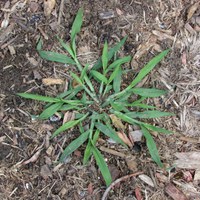Dakota Gardener: Prevent Crabgrass This Spring
(Click an image below to view a high-resolution image that can be downloaded)
By Esther McGinnis, Horticulturist
NDSU Extension
Mother Nature can be extraordinarily fickle in the northern Great Plains.
One day you are admiring spring tulips in your short sleeves; the next day, sleet pellets will coat the ground. This extreme weather variability dampens our hopes and makes timing the application of crabgrass pre-emergent herbicide difficult to do.
Crabgrass is an annual weed with a wide leaf that can look unattractive to homeowners wanting a uniform-textured lawn.
While crabgrass plants do not overwinter, new seeds germinate each spring from an abundant soil seedbank when the average soil temperature, at a depth of 2 inches, reaches 55 F for three to five days. Seeds will continue to germinate throughout summer, but the majority will germinate at soil temperatures between 60 and 70 F.
With our late spring, turf soil temperatures have been slow to rise. However, the soil will warm very quickly with warmer air temperatures. Apply a crabgrass pre-emergent herbicide before we reach an average soil temperature of 55 F.
To check on the average turf soil temperature in your area, please consult the North Dakota Agricultural Weather Network (NDAWN) website at https://ndawn.ndsu.nodak.edu/soil-temps.html.
Of the two numbers that appear on the NDAWN soil map, the second number represents turf soil temperature, while the first number is the temperature of bare soil.
Crabgrass preventers are a class of pre-emergent herbicides that are applied before the crabgrass seeds germinate. Most pre-emergent herbicides will not provide effective control after germination.
Commonly available crabgrass preventers for established lawns include active ingredients such as pendimethalin, prodiamine and dithiopyr. Of these three herbicides, dithiopyr is the only one that has early postemergent activity. Dithiopyr can control crabgrass seedlings that are in the one- to three-leaf stage if you missed the window for pre-emergent applications.
When applying a crabgrass preventer, follow all label instructions.
To be effective, you need to apply 1/2 inch of water to dissolve the granules and move the herbicide into the top layer of soil. Once dissolved, the crabgrass preventer will form a barrier in the soil.
A word of caution: Do not apply a standard crabgrass preventer to newly seeded or overseeded lawns. The pre-emergent herbicide cannot differentiate between pesky crabgrass seeds and desirable lawn seeds.
Instead, lawn products that contain the active ingredient siduron (Tuperan) can be used in that situation. Alternatively, a starter fertilizer that contains the active ingredient mesotrione (Scotts Turf Builder Starter Food for New Grass Plus Weed Preventer) also is available.
NDSU Agriculture Communication - April 28, 2020
| Source: | Esther McGinnis, 701-231-7971, esther.mcginnis@ndsu.edu |
|---|---|
| Editor: | Ellen Crawford, 701-231-5391, ellen.crawford@ndsu.edu |




